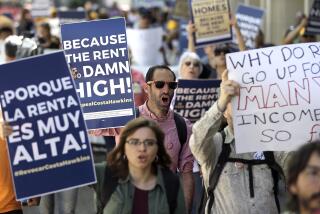The Door Stays Open : Santa Monica Landlords’ Measure Survives Renters’ Court Challenge
- Share via
A Santa Monica tenant organization has failed to kill a controversial June ballot measure that would weaken the city’s rent control law by allowing unlimited rent increases on vacant apartment units.
Santa Monica Superior Court Judge David M. Rothman this week ruled that the measure, known as the Tenant Incentive Program, technically complied with election laws, despite “many flaws, uncertainties and failures.”
The decision was a setback for Santa Monicans for Renters’ Rights, the tenant organization that sued to have the measure declared invalid on grounds that petitions signed by supporters contained major drafting errors. Leaders of the group said they would consider an appeal, but were also prepared to oppose the plan at the polls.
“It’s not a surprise,” said Charlotte Houghton, a member of the tenant activist organization’s steering committee. “We knew it could go either way. . . . We have always been prepared to win at the ballot box on June 3. And we have already started our fund-raising and political organizing.”
Geoffrey S. Strand, a spokesman for the landlord organization known as ACTION (A Commitment to Insure Owners’ Needs), which is backing the Tenant Incentive Program, said his group expected to win the court case. He said the lawsuit, which cost about $14,000 to defend, was groundless.
“We knew that the suit was nothing but technical nit-picking and the judge said exactly what we expected,” Strand said. “The (tenant activists) are desperate to keep it off the ballot. . . . But the court has spoken.”
The Tenant Incentive Program would amend the portion of the Santa Monica rent control law that prohibits a landlord from raising the rent on vacant apartment units. Under current law, the city’s Rent Control Board awards yearly rent increases. The Tenant Incentive Program would empower an apartment owner to raise the rent every time a unit was vacated. In return, supporters said a landlord would be forced to share his profits with tenants.
Earlier this year, however, City Atty. Robert M. Myers concluded that the measure actually offered nothing to tenants because of a “major drafting error.” Myers added that the measure contained several technical flaws.
His report was the basis for the suit filed by Santa Monicans for Renters’ Rights. In court on Tuesday, attorney Roger Diamond argued that the petitions circulated by the measure’s supporters were potentially misleading because of sloppy preparation.
He noted that certain legal language was unclear and that other paragraphs were in the wrong order. Under the circumstances, Diamond said people who signed a petition supporting the initiative may have been confused.
“This is a serious matter,” Diamond told Judge Rothman. “All of the (problems) in combination render this measure fatally defective.”
Deputy City Atty. Mary Strobel argued against declaring the measure invalid. Despite the wording problems, Strobel said officials had determined that the Tenant Incentive Program complied with election code provisions.
“If it is in substantial compliance, it can be misleading and unintelligible and that doesn’t matter?” Rothman asked.
“That is correct,” Strobel replied.
Attorney Sherman Stacy, speaking on behalf of the measure’s supporters, said the initiative is clearly written. Stacy said the opponents of the Tenant Incentive Program had failed to produce any proof that the voters were misled. When Rothman asked why the measure was not better prepared, Stacy said it was put together by “unartful draftsmen” and “just plain citizens.”
“A reasonable person,” can understand this measure, Stacy said. “Attempts to have the courts reach (other) conclusions . . . are not supported by the facts.”
At the end of the 90-minute hearing, Rothman retired to his chambers. About 20 minutes later he issued a handwritten decision in favor of keeping the Tenant Incentive Program on the ballot. Rothman acknowledged that the measure has technical problems, but added that it is in compliance with the law.
The judge said that he was not ruling on whether the petition for the measure was “well drafted, meritorious or clear.”
The Tenant Incentive Program will be back in court on Monday when supporters will ask a Los Angeles Superior Court judge to change the ballot language drafted by the Santa Monica City Council.
They contend that the council’s ballot description gives the false impression that apartment units would be removed from rent control protections under the Tenant Incentive Program.
They proposed that the language be changed to say that the measure would allow “apartment owners the option of renting voluntarily vacated apartments at market value provided certain cash payments are made to existing tenants subject to supervision by the Rent Control Board.”
Promoters of the plan have said that an apartment owner would share the profits from the rent increase with the remaining “qualified tenants” by multiplying the amount of one month’s rent increase by 10 and dispersing the sum among the building’s “qualified units.”
For example, a landlord who raised the rent on an apartment by $400 a month would divide $4,000 among his tenants one time, according to the landlords. An apartment owner would not be allowed to raise his rent if the vacancy was the result of an unfair eviction as determined by the city’s Rent Control Board and the unit would be under rent control again once the rent had been raised.
More to Read
Sign up for Essential California
The most important California stories and recommendations in your inbox every morning.
You may occasionally receive promotional content from the Los Angeles Times.






